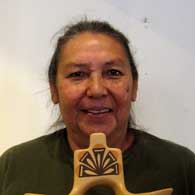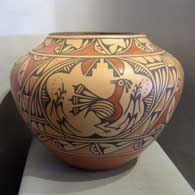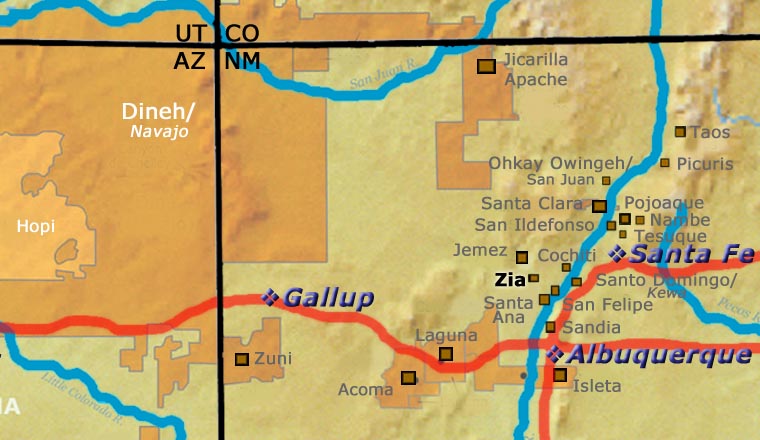
Ruby Panana
Zia

A daughter of Seferina Bell, Ruby Panana was born in Zia Pueblo in the early 1950s. She grew up watching her famous mother making pottery but didn't begin herself until she was almost 30 years old. She finished high school at Albuquerque's West Mesa High School, then went on to the University of New Mexico in search of a teaching degree. However, her scholarships didn't cover all that she needed covered and she eventually returned to Zia Pueblo. She met and married her husband and moved to his home at Jemez Pueblo. As much as Ruby now lives at Jemez Pueblo, she still makes her pottery in the Zia style she learned from her mother. In addition to her famous mother Ruby counts potters Kathryn Pino and Eleanor Pino Griego among her family.
Since immersing herself full time in making pottery, Ruby has blazed a trail for other Zia potters by participating in shows at the Walatowa Visitor Center, the Heard Museum Guild Indian Arts Fair and Market in Phoenix, the Santa Fe Indian Market, the Southwest Indian Art Fair in Tucson and the Eight Northern Indian Pueblos Arts & Crafts Show in Espanola, NM. She has won ribbons for Best of Show from Walatowa, First and Second Place at Santa Fe Indian Market, Best of Pottery at the Heard, First and Second Place at Eight Northern Indian Pueblos Arts & Crafts Show and the Purchase Award at Tucson (meaning: the Arizona State Museum bought the pot she entered for judging).
Ruby tells us her favorite shapes to work with are water jars and her favorite designs to paint include parrots and rainbows. Like many Native American potters, Ruby says she gets her inspiration from the clay itself. That's part of what causes her to enjoy making pottery so much. When she's not making pottery you might find Ruby near a basketball game: her favorite team is the UConn Women's Basketball Team. She also enjoys regular visits to the casino (although she doesn't ever win much) and she's lately gotten into a business buying storage units...
100 West San Francisco Street, Santa Fe, New Mexico 87501
(505) 986-1234 - www.andreafisherpottery.com - All Rights Reserved

Zia Pueblo

A typical view on the Zia Reservation
Zia Pueblo is situated in the Jemez Mountains with Jemez Pueblo to the north and Santa Ana Pueblo to the south. Despite its picture postcard setting, Zia's history for the last four hundred years has been difficult.
Antonio de Espejo led a small troop of Spanish explorers up the Jemez River and discovered Zia Pueblo in 1583. Espejo estimated there were about 4,000 inhabitants in a city of house blocks up to three and four stories high with five major plazas and many smaller ones. "The people are clean. The women wear a blanket over their shoulders tied with a sash at their waist - their hair cut in front, and the rest plaited so that it forms two braids, and above a blanket of turkey feathers," is how Espejo's scribe recorded it.
Zia today is a water-poor community of about 800, most of whose residents work away from the pueblo.
The people of Zia participated in the Pueblo Revolt of 1680 and when Spanish troops returned in 1682 and 1687, the Zias were able to repulse them. When more Spanish troops returned in 1688 they were finally successful in conquering the Zias. The Spanish killed many people, burned the pueblo and took many slaves back to Mexico with them. When Don Diego de Vargas returned to northern Nuevo Mexico in 1692, the Zias sued for peace and accepted the rule of Spain almost immediately. However, the new Spanish government did little to protect the pueblos from the raids of nomadic Ute, Apache, Comanche and Navajo warriors. Zia fortunes slid in many ways and by the 1890's the tribe was down to just 98 members.
Today, the Pueblo of Zia numbers about 800 people, many of whom are active artists producing everything from pottery to jewelry to baskets to paintings, sculptures and wood carvings.
Pottery was a Zia mainstay for at least two hundred years. The balance of trade was food from Santa Ana, Jemez and San Felipe in return for pottery from Zia. Pottery still remains Zia's largest home-grown cash crop.
Zia pottery is Keresan and as such, shares design characteristics with other important Keresan pottery, especially Acoma and Laguna ware. They all have their favorite geometric patterns, stylized birds, rainbows and flowers, but each maintains its own individual images and colors.
Where Acoma and Laguna's bird is a parrot, Zia's is a roadrunner. Acoma's black and orange on stark white is contrasted by Zia's dark brown and brownish red on creamy white. Further, Acoma's hard, paper-thin, white clay ollas differ greatly from Zia's sturdy, slightly granular, basalt-tempered red clay jars. Because of their unique local clay and their traditional designs and shapes, Zia pottery is unique and easily distinguished from the pottery of other pueblos.
When New Mexico became a territory (and then a state), some of the symbols involved were sourced from Zia Pueblo. The roadrunner often pictured on Zia pottery became the official New Mexico state bird and the Zia sun symbol (a circle with four parallel lines in four groups pointing in the four directions) became a state symbol depicted in many places, including the state flag.
100 West San Francisco Street, Santa Fe, New Mexico 87501
(505) 986-1234 - www.andreafisherpottery.com - All Rights Reserved

Ascenciona Galvan Pino Family Tree
Disclaimer: This "family tree" is a best effort on our part to determine who the potters are in this family and arrange them in a generational order. The general information available is questionable so we have tried to show each of these diagrams to living members of each family to get their input and approval, too. This diagram is subject to change should we get better info.
- Rufina Galvan (c. 1882-) & Celestino Galvan
- Ascenciona Galvan Pino (c. 1900-) and Joe Pino
- Seferina Bell (1920-1986)
- Ruby Panana (1954-)
- Florinda Shije (niece)
- Katherine Pino (c. 1935-2017)
Her student:
- Veronica Pino Baca (1934-)
- Laura Pino (c. 1930s-)
- Eleanor Pino Griego (1953-)
- Reyes Pino (c. 1950s-)
- Tomasita Pino (c. 1930s-)
- Seferina Bell (1920-1986)
Some of the above info is drawn from Southern Pueblo Pottery, 2000 Artist Biographies, by Gregory Schaaf, © 2002, Center for Indigenous Arts & Studies
Other info is derived from personal contacts with family members and through interminable searches of the Internet and cross-examination of the data found.
(505) 986-1234 - www.andreafisherpottery.com - All Rights Reserved
